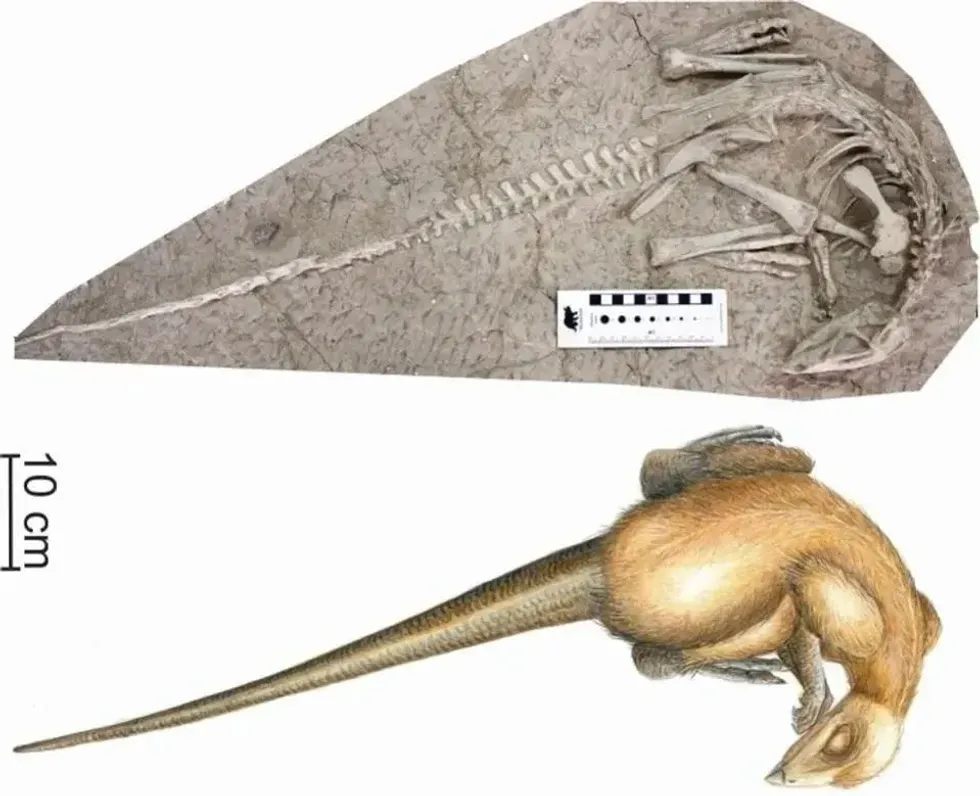A groundbreaking study has challenged the long-held belief that China’s remarkably preserved dinosaur fossils were created by volcanic events similar to those at Pompeii.
The Yixian Formation in northeast China’s Liaoning Province, dating back 120 to 130 million years, has been a treasure trove of perfectly preserved fossils for over two decades.
These extraordinary finds include hundreds of feathered dinosaur skeletons, along with insects, plants, shells and fish.
Researchers have now discovered that these fossils formed during a brief 93,000-year period without any volcanic activity, overturning previous theories about their preservation.
For decades, scientists believed these fossils were preserved by sudden volcanic events, much like the victims of Mount Vesuvius at Pompeii.
Previous studies suggested multiple volcanic events occurred over a million years, with lahars – fast-moving mud slurries – or pyroclastic flows repeatedly burying and preserving creatures.
 Changmiania liaoningensis discovered in the Yixian Formation and now hosted at the Liaoning Paleontological Museum in Shenyang, ChinaC. Ciselet/YANG et al. 2020/PeerJ
Changmiania liaoningensis discovered in the Yixian Formation and now hosted at the Liaoning Paleontological Museum in Shenyang, ChinaC. Ciselet/YANG et al. 2020/PeerJHowever, researchers now argue that lahars would have been too violent to preserve intact skeletons.
Unlike Pompeii’s victims, who were found in contorted ‘pugilistic’ positions due to extreme heat, the Chinese fossils show no signs of burning or heat damage.
Many specimens were found with feathers and fur intact, which would have been destroyed by volcanic activity.
Instead, researchers found evidence pointing to sudden burrow collapses as the primary cause of preservation.
LATEST DEVELOPMENTS:
Rock cores surrounding the fossils revealed coarse grains, whilst finer grains were found immediately around and within the skeletons.
This pattern suggests the animals experienced gradual decay, allowing fine grains to seep in and fill the voids whilst bones remained intact.
Many specimens were discovered in sleeping positions, with arms and tails tucked cosily around their bodies.
Heavy rainfall during this period likely destabilised the ground, causing burrows to collapse and entomb their inhabitants.
This theory also explains a remarkable fossil showing an early mammal and small dinosaur locked in combat, possibly preserved when a burrow collapsed during an invasion attempt.
The findings challenge how we view extraordinary fossil preservation, according to study coauthor Paul Olsen from Columbia Climate School’s Lamont-Doherty Earth Observatory.
“These are probably the most important dinosaur discoveries of the last 120 years,” says Olsen.
“That is, to ascribe extraordinary causes, i.e. miracles, to ordinary events when we don’t understand their origins. These fossils are just a snapshot of everyday deaths in normal conditions over a relatively brief time.”
Using advanced dating techniques on zircon minerals, lead author Scott MacLennan precisely dated the fossils to 125.8 million years ago, within a period of less than 93,000 years.
The fossils were found embedded between volcanic deposits but formed during a non-volcanic period.
The implications of this research extend beyond China’s Yixian Formation.
Similar perfectly preserved fossils could be found in other locations with comparable ancient environments.
Promising sites include a rock quarry on the North Carolina-Virginia border, where thousands of preserved insects have been discovered.
Additional locations in Connecticut have shown potential for similar finds.
A former quarry in North Bergen, New Jersey, now surrounded by modern development, has previously yielded excellently preserved fish and reptile fossils.
“It’s just that there is no place else where such intense collecting has been done in this kind of environment,” Olsen said.